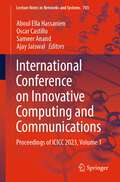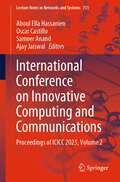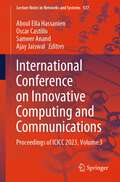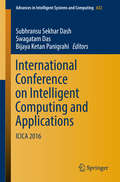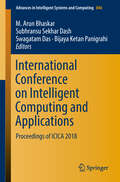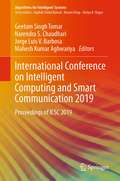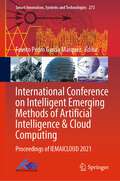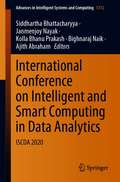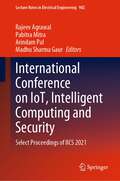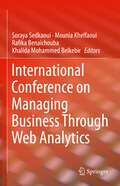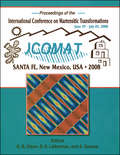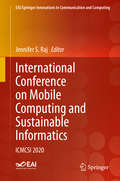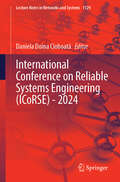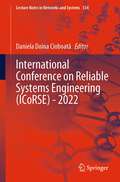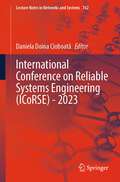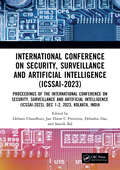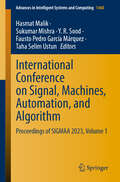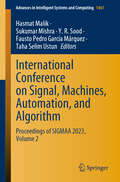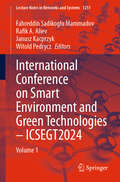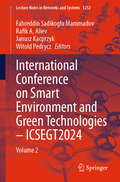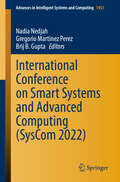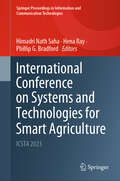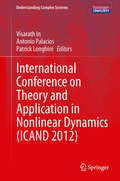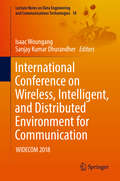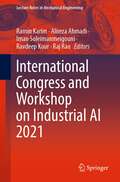- Table View
- List View
International Conference on Innovative Computing and Communications: Proceedings of ICICC 2023, Volume 1 (Lecture Notes in Networks and Systems #703)
by Oscar Castillo Aboul Ella Hassanien Sameer Anand Ajay JaiswalThis book includes high-quality research papers presented at the Sixth International Conference on Innovative Computing and Communication (ICICC 2023), which is held at the Shaheed Sukhdev College of Business Studies, University of Delhi, Delhi, India, on February 17–18, 2023. Introducing the innovative works of scientists, professors, research scholars, students and industrial experts in the field of computing and communication, the book promotes the transformation of fundamental research into institutional and industrialized research and the conversion of applied exploration into real-time applications.
International Conference on Innovative Computing and Communications: Proceedings of ICICC 2023, Volume 2 (Lecture Notes in Networks and Systems #731)
by Oscar Castillo Aboul Ella Hassanien Sameer Anand Ajay JaiswalThis book includes high-quality research papers presented at the Sixth International Conference on Innovative Computing and Communication (ICICC 2023), which is held at the Shaheed Sukhdev College of Business Studies, University of Delhi, Delhi, India, on February 17–18, 2023. Introducing the innovative works of scientists, professors, research scholars, students, and industrial experts in the field of computing and communication, the book promotes the transformation of fundamental research into institutional and industrialized research and the conversion of applied exploration into real-time applications.
International Conference on Innovative Computing and Communications: Proceedings of ICICC 2023, Volume 3 (Lecture Notes in Networks and Systems #537)
by Oscar Castillo Aboul Ella Hassanien Sameer Anand Ajay JaiswalThis book includes high-quality research papers presented at the Sixth International Conference on Innovative Computing and Communication (ICICC 2023), which is held at the Shaheed Sukhdev College of Business Studies, University of Delhi, Delhi, India, on February 17–18, 2023. Introducing the innovative works of scientists, professors, research scholars, students, and industrial experts in the field of computing and communication, the book promotes the transformation of fundamental research into institutional and industrialized research and the conversion of applied exploration into real-time applications.
International Conference on Intelligent Computing and Applications
by Bijaya Ketan Panigrahi Swagatam Das Subhransu Sekhar DashSecond International Conference on Intelligent Computing and Applications was the annual research conference aimed to bring together researchers around the world to exchange research results and address open issues in all aspects of Intelligent Computing and Applications. The main objective of the second edition of the conference for the scientists, scholars, engineers and students from the academia and the industry is to present ongoing research activities and hence to foster research relations between the Universities and the Industry. The theme of the conference unified the picture of contemporary intelligent computing techniques as an integral concept that highlights the trends in computational intelligence and bridges theoretical research concepts with applications. The conference covered vital issues ranging from intelligent computing, soft computing, and communication to machine learning, industrial automation, process technology and robotics. This conference also provided variety of opportunities for the delegates to exchange ideas, applications and experiences, to establish research relations and to find global partners for future collaboration.
International Conference on Intelligent Computing and Applications: Proceedings of ICICA 2018 (Advances in Intelligent Systems and Computing #846)
by Bijaya Ketan Panigrahi Swagatam Das Subhransu Sekhar Dash M. Arun BhaskarThe book is a collection of best papers presented at the International Conference on Intelligent Computing and Applications (ICICA 2018), held at Velammal Engineering College, Chennai, India on 2–3 February 2018. Presenting original work in the field of computational intelligence and power and computing technology, it focuses on soft computing applications in power systems; power-system modeling and control; FACTS devices – applications in power systems; power-system stability and switchgear and protection; power quality issues and solutions; smart grids; green and renewable energy technologies; optimization techniques in electrical systems; power electronics controllers for power systems; power converters and modeling; high voltage engineering; diagnosis and sensing systems; and robotics.
International Conference on Intelligent Computing and Smart Communication 2019: Proceedings of ICSC 2019 (Algorithms for Intelligent Systems)
by Narendra S. Chaudhari Geetam Singh Tomar Jorge Luis V. Barbosa Mahesh Kumar AghwariyaThis book gathers high-quality research papers presented at the First International Conference, ICSC 2019, organised by THDC Institute of Hydropower Engineering and Technology, Tehri, India, from 20 to 21 April 2019. The book is divided into two major sections – Intelligent Computing and Smart Communication. Some of the areas covered are Parallel and Distributed Systems, Web Services, Databases and Data Mining Applications, Feature Selection and Feature Extraction, High-Performance Data Mining Algorithms, Knowledge Discovery, Communication Protocols and Architectures, High-speed Communication, High-Voltage Insulation Technologies, Fault Detection and Protection, Power System Analysis, Embedded Systems, Architectures, Electronics in Renewable Energy, CAD for VLSI, Green Electronics, Signal and Image Processing, Pattern Recognition and Analysis, Multi-Resolution Analysis and Wavelets, 3D and Stereo Imaging, and Neural Networks.
International Conference on Intelligent Emerging Methods of Artificial Intelligence & Cloud Computing: Proceedings of IEMAICLOUD 2021 (Smart Innovation, Systems and Technologies #273)
by Fausto Pedro García MárquezThis book consists of different accepted papers of the conference. Firstly, the artificial intelligence and its application-related topics are provided. Secondly, cloud computing and related topics are also provided. The book has been designed to help research organisations and business leaders from across industries to transform their organisations into AI-driven disruptors. The utility of the technology in the face of massive globally interconnected complexity is explored. The significant characteristics of IEMAICLOUD are the promotion of inevitable dialogue between scientists, researchers, engineers, corporate’s and scholar’s students to mitigate the gap between academia, industry and governmental ethics which has been fostered through keynote speeches, workshops, panel discussion and oral presentations by eminent researchers in relevant field. The industry personnel depict cutting-edge researches in artificial intelligence and cloud computing to convey academia regarding real-time scenario and practical findings. Conference has been well equipped with talks by industry experts on the state of the art in computer science, lectures by eminent scientists designed to inspire and inform presentations by innovative researchers coming from 20+ countries from Europe and abroad. There has been discussion-oriented sessions and networking breaks to enable collaborations. Papers consist abstract, result, discussions and conclusions by the help of different tables and diagrams.
International Conference on Intelligent and Smart Computing in Data Analytics: ISCDA 2020 (Advances in Intelligent Systems and Computing #1312)
by Ajith Abraham Siddhartha Bhattacharyya Janmenjoy Nayak Bighnaraj Naik Kolla Bhanu PrakashThis book is a collection of best selected research papers presented at International Conference on Intelligent and Smart Computing in Data Analytics (ISCDA 2020), held at K L University, Guntur, Andhra Pradesh, India. The primary focus is to address issues and developments in advanced computing, intelligent models and applications, smart technologies and applications. It includes topics such as artificial intelligence and machine learning, pattern recognition and analysis, computational intelligence, signal and image processing, bioinformatics, ubiquitous computing, genetic fuzzy systems, hybrid evolutionary algorithms, nature-inspired smart hybrid systems, Internet of things, industrial IoT, health informatics, human–computer interaction and social network analysis. The book presents innovative work by leading academics, researchers and experts from industry.
International Conference on IoT, Intelligent Computing and Security: Select Proceedings of IICS 2021 (Lecture Notes in Electrical Engineering #982)
by Pabitra Mitra Rajeev Agrawal Madhu Sharma Gaur Arindam PalThis book comprises select peer-reviewed papers from the International Conference on IoT, Intelligent Computing and Security, IICS 2021. The contents focus on the latest research in artificial intelligence, IoT, intelligent computing, and leading technological convergence security challenges. The book also discusses AI-driven automation of highly connected smart devices across the globe presenting the fast technological shift with the futuristic scenario, bursting perspective of IoT, computational intelligence, and security concerns. This book supports the transfer of vital knowledge to the next generation of researchers, students, and practitioners in academia and industry.
International Conference on Managing Business Through Web Analytics
by Soraya Sedkaoui Mounia Khelfaoui Rafika Benaichouba Khalida Mohammed BelkebirThis book presents the proceedings of the International Conference on Managing Business through Web Analytics (ICMBWA 2021). The conference provides a global forum for sharing knowledge and results in theory, methodology, and applications of Web Analytics and their role in the formulation and the orientation of businesses’ strategies. The aim of the conference is to provide a platform for researchers and practitioners from both academia and industry to meet and share their works in the field. Is an excellent resource for scholars, experts and industrial in the fields represented, as well as Ph.D. students seeking an entryway into current research in data analytics, Web analytics, machine learning algorithms, and their various applications within businesses.
International Conference on Martensitic Transformations (ICOMAT) 2008
by Gregory Olson David Lieberman Avadh SaxenaDuring the week of June 29 - July 5, 2008, over 300 scientists and engineers from 30 countries spanning five continents converged at the historic La Fonda Hotel in the city of Santa Fe, New Mexico, USA to participate in the 12th International Conference on Martensitic Transformations (ICOMAT-08) to fathom the peculiar world of certain crystalline materials that undergo structural change when cooled or stressed. Many of these materials can restore their original shape when reheated, thus the name "Shape Memory Alloys". In the spirit of Santa Fe, a central theme of ICOMAT-08 was INTEGRATION across many dimensions.
International Conference on Mobile Computing and Sustainable Informatics: ICMCSI 2020 (EAI/Springer Innovations in Communication and Computing)
by Jennifer S. RajSustainability and mobile computing embraces a wide range of Information and Communication Technologies [ICT] in recent times. This book focuses more on the recent research and development works in almost all the facets of sustainable, ubiquitous computing and communication paradigm. The recent research efforts on this evolving paradigm help to advance the technologies for next-generation, where socio-economic growth and sustainability poses significant challenges to the computing and communication infrastructures. The main purpose of this book is to promote the technical advances and impacts of sustainability and mobile computing to the informatics research. The key strands of this book include green computing, predictive models, mobility, data analytics, mobile computing, optimization, Quality of Service [QoS], new communicating and computing frameworks, human computer interaction, Artificial Intelligence [AI], communication networks, risk management, Ubiquitous computing, robotics, smart city and applications. The book has also addressed myriad of sustainability challenges in various computing and information processing infrastructures.
International Conference on Reliable Systems Engineering (Lecture Notes in Networks and Systems #1129)
by Daniela Doina CioboatăThis book comprises peer-reviewed papers from the fourth “International Conference of Reliable Systems Engineering (ICoRSE 2024)” that will take place in Bucharest, Romania, between 05 and 06 September 2024. The first three editions of the conference brought together participants from different countries in Europe, North America, and Asia, such as England, Albania, Austria, Bulgaria, Canada, Czech Republic, Germany, France, Italy, Portugal, Turkey, Ukraine, Uzbekistan, and Vietnam. The book presents state-of-the-art research in the field of mechatronics and other closely related areas and covers a wide range of topics in theoretical and applied mechanics: cyber-physical systems; research and developments in the field of robotics, artificial intelligence and computer visions; smart bio-medical and bio-mechatronic systems; new and intelligent materials and structures; modeling and simulation in mechanics and mechatronics; smart mechatronic production and control systems; optics systems; big data collecting, processing and analyzing; micro- and nanotechnology; automation; manufacturing optimization; and others. Since the book’s chapters provide contributions of researchers and professionals in public and private organizations, they reflect a clear picture of the novelties attained in the leading-edge sciences that are in the scope of the conference. It is our belief that the book will be useful to both students and researchers in all areas of engineering, who will each find at least one topic worthy of their interest in this work.
International Conference on Reliable Systems Engineering (Lecture Notes in Networks and Systems #534)
by Daniela Doina CioboatăThis book provides both researchers in the academia, students, and industrial experts the chance to exchange new ideas, build relations, and find virtual partners. It is a scientific event whose proceedings have set a very high standard. ICORSE’s distinctive feature is represented by its breadth of topics: mechatronics, integronics and adaptronics; reliable systems engineering; cyber-physical systems; optics; theoretical and applied mechanics; robotics; modelling and simulation; smart integrated control systems; computer imaging processing; smart bio-medical and bio-mechatronic systems; MEMS and NEMS; new materials; sensors and transducers; nano-chemistry, physical chemistry of biological systems; micro- and nanotechnology; system optimization; communications, renewable energy and environmental engineering. They all come together to deliver a clear picture of the state of the art reached in these areas so far.
International Conference on Reliable Systems Engineering (Lecture Notes in Networks and Systems #762)
by Daniela Doina CioboatăThis book comprises state-of-the-art research results in the field of mechatronics and other closely related areas and that will be presented on occasion of the third “International Conference of Reliable Systems Engineering (ICoRSE 2023)” that will take place in Bucharest, Romania, between 07–08 September 2023.The first two ICoRSE editions brought together professors, Ph.D. students, and researchers in Europe, North America, and Asia, in countries such as: England, Albania, Austria, Bulgaria, Canada, Czech Republic, Germany, France, Italy, Portugal, Turkey, Ukraine, Uzbekistan, and Vietnam. In this year’s edition of the conference, we have benefitted from the inclusion in the scientific committee of the conference of professors in all of these countries, and we cover a wide variety of topics, such as: theoretical and applied mechanics; cyber-physical systems, robotics, smart bio-medical and bio-mechatronic systems, new and intelligent materials and structures, modelling and simulation in mechanics and mechatronics, smart mechatronic production and control system, optics, control systems, big data modelling, micro- and nanotechnology, automation, manufacturing optimization, and other.Since the book´s chapters represent contributions of scholars who work in both state-funded institutions and in the business environment, they reflect a clear picture of the novelties attained in the leading-edge sciences that are in the scope of the conference. It is our belief that the book is useful to both students and researchers in all areas of engineering, who will each find at least one topic worthy of their interest in this work.
International Conference on Security, Surveillance and Artificial Intelligence (ICSSAI-2023): Proceedings of the International Conference on Security, Surveillance and Artificial Intelligence (ICSSAI-2023), Dec 1–2, 2023, Kolkata, India
by Debasis Chaudhuri Debashis Das Sauvik Bal Jan Harm C PretoriusThe International Conference on Security, Surveillance & Artificial Intelligence (ICSSAI2023) was held in West Bengal, India during December 1–2, 2023. The conference was organized by the Techno India University, one of the renowned universities in the state of West Bengal which is committed for generating, disseminating and preservingknowledge.
International Conference on Signal, Machines, Automation, and Algorithm: Proceedings of SIGMAA 2023, Volume 1 (Advances in Intelligent Systems and Computing #1460)
by Fausto Pedro García Márquez Hasmat Malik Sukumar Mishra Y. R. Sood Taha Selim UstunThis book is a set of best quality peer-reviewed innovative research papers from the International Conference on Signals, Machines, Automation and Algorithm (SIGMAA 2023), held at Shoolini University, India, during 15–16 December 2023 in hybrid mode. This book has originality of work with the innovative ideas regarding artificial intelligence (AI) and its applications in the field of communication, computing, and power technologies.
International Conference on Signal, Machines, Automation, and Algorithm: Proceedings of SIGMAA 2023, Volume 2 (Advances in Intelligent Systems and Computing #1461)
by Fausto Pedro García Márquez Hasmat Malik Sukumar Mishra Y. R. Sood Taha Selim UstunThis book is a set of best quality peer-reviewed innovative research papers from the International Conference on Signals, Machines, Automation and Algorithm (SIGMAA 2023), held at Shoolini University, India, during 15–16 December 2023 in hybrid mode. This book has originality of work with the innovative ideas regarding artificial intelligence (AI) and its applications in the field of communication, computing, and power technologies.
International Conference on Smart Environment and Green Technologies – ICSEGT2024: Volume 1 (Lecture Notes in Networks and Systems #1251)
by Witold Pedrycz Janusz Kacprzyk Rafik A. Aliev Fahreddin Sadikoglu MammadovThis book compiles state-of-the-art studies and real-world applications in ecosystems and smart environments. It covers important subjects like creating a sustainable economy, green and renewable energy, and IoT-powered industrial and agricultural systems. Along with providing insights into theory, modelling, and the deployment of smart cities and infrastructure, the book also examines the use of AI in the earth and environmental sciences and economy. The book is intended to be a priceless tool for scholars, professionals, and recent graduates. It acts as a manual and source of inspiration for promoting environmentally friendly technologies and sustainable solutions. It opens the door for creating intelligent systems that maximise resource use, reduce carbon footprints, and enhance general quality of life by incorporating the most recent technological developments.
International Conference on Smart Environment and Green Technologies – ICSEGT2024: Volume 2 (Lecture Notes in Networks and Systems #1252)
by Witold Pedrycz Janusz Kacprzyk Rafik A. Aliev Fahreddin Sadikoglu MammadovThis book compiles state-of-the-art studies and real-world applications in ecosystems and smart environments. It covers important subjects like creating a sustainable economy, green and renewable energy, and IoT-powered industrial and agricultural systems. Along with providing insights into theory, modelling, and the deployment of smart cities and infrastructure, the book also examines the use of AI in the earth and environmental sciences and economy. The book is intended to be a priceless tool for scholars, professionals, and recent graduates. It acts as a manual and source of inspiration for promoting environmentally friendly technologies and sustainable solutions. It opens the door for creating intelligent systems that maximise resource use, reduce carbon footprints, and enhance general quality of life by incorporating the most recent technological developments.
International Conference on Smart Systems and Advanced Computing (Advances in Intelligent Systems and Computing #1451)
by Gregorio Martinez Perez Nadia Nedjah Brij B. GuptaThis book presents the International Conference on Smart Systems and Advanced Computing (SysCom 2022) that features scientific work on smart solution concepts. It covers collective computational intelligence, which encompasses smart device interactions, smart surroundings, and smart ability to interact, as well as information technology support for these areas. It concentrates on cutting-edge research and technologies in smart systems and advanced computing for intelligent autonomous systems. The objectives of SysCom 2022 are to provide a premier international platform for deliberations on strategies, recent trends, innovative approaches, discussions, and presentations on the most recent development in the field of smart system technology from the perspective of providing awareness and its best practices for the real world.
International Conference on Systems and Technologies for Smart Agriculture: ICSTA 2023 (Springer Proceedings in Information and Communication Technologies)
by Phillip G. Bradford Himadri Nath Saha Hena RayThe book contains peer-reviewed proceedings of the International Conference on Systems and Technologies for Smart Agriculture, ICSTA 2023. It focuses on the applications of artificial intelligence, the Internet of Things, and robotics technologies to transform traditional agriculture into smart agriculture. The topics covered in this book include cyber-physical systems and IoT, automation and mechanization, artificial intelligence/machine learning, security and blockchain, big data, data management, and analytics, agricultural health, additive technologies and food engineering, sensor and sensing systems, and remote sensing and aerial imaging. This book serves as a bridge between academic research, industry initiatives, and governmental policies.
International Conference on Theory and Application in Nonlinear Dynamics (ICAND #2012)
by Visarath In Antonio Palacios Patrick LonghiniA collection of different lectures presented by experts in the field of nonlinear science provides the reader with contemporary, cutting-edge, research works that bridge the gap between theory and device realizations of nonlinear phenomena. Representative examples of topics covered include: chaos gates, social networks, communication, sensors, lasers, molecular motors, biomedical anomalies, stochastic resonance, nano-oscillators for generating microwave signals and related complex systems. A common theme among these and many other related lectures is to model, study, understand, and exploit the rich behavior exhibited by nonlinear systems to design and fabricate novel technologies with superior characteristics. Consider, for instance, the fact that a shark's sensitivity to electric fields is 400 times more powerful than the most sophisticated electric-field sensor. In spite of significant advances in material properties, in many cases it remains a daunting task to duplicate the superior signal processing capabilities of most animals. Since nonlinear systems tend to be highly sensitive to perturbations when they occur near the onset of a bifurcation, there are also lectures on the general topic of bifurcation theory and on how to exploit such bifurcations for signal enhancements purposes. This manuscript will appeal to researchers interested in both theory and implementations of nonlinear systems.
International Conference on Wireless, Intelligent, and Distributed Environment for Communication: Widecom 2018 (Lecture Notes On Data Engineering And Communications Technologies #18)
by Isaac Woungang Sanjay Kumar DhurandherThis book presents the proceedings of the International Conference on Wireless Intelligent and Distributed Environment for Communication (WIDECOM 2018), organized by SRM University, NCR Campus, New Delhi, India, February 16-18, 2018. The conference focuses on challenges with respect to the dependability of integrated applications and intelligence-driven security threats against the platforms supporting these applications.The WIDECOM 2018 proceedings features papers addressing issues related to the new dependability paradigms, design, control, and management of next generation networks, performance of dependable network computing and mobile systems, protocols that deal with network computing, mobile/ubiquitous systems, cloud systems, and Internet of Things (IoT) systems. The proceeding is a valuable reference for researchers, instructors, students, scientists, engineers, managers, and industry practitioners, in industry, in the aforementioned areas. The book’s structure and content is organized in such a manner that makes it useful at a variety of learning levels.Presents the proceedings of the International Conference on Wireless Intelligent and Distributed Environment for Communication (WIDECOM 2018), organized by SRM University, NCR Campus, New Delhi, India, February 16-18, 2018;Includes an array of topics related to new dependability paradigms, design, control, and management of next generation networks, performance of dependable network computing and mobile systems, protocols that deal with network computing, mobile/ubiquitous systems, cloud systems, and Internet of Things (IoT) systems;Addresses issues related to the design and performance of dependable network computing and systems and to the security of these systems.
International Congress and Workshop on Industrial AI 2021 (Lecture Notes in Mechanical Engineering)
by Alireza Ahmadi Ramin Karim Iman Soleimanmeigouni Ravdeep Kour Raj RaoThis proceedings of the International Congress and Workshop on Industrial AI 2021 encompasses and integrates the themes and topics of three conferences, eMaintenance, Condition Monitoring and Diagnostic Engineering management (COMADEM), and Advances in Reliability, Maintainability and Supportability (ARMS) into a single resource. The 21st century is witnessing the emerging extensive applications of Artificial Intelligence (AI) and Information Technologies (IT) in industry. Industrial Artificial Intelligence (IAI) integrates IT with Operational Technologies (OT) and Engineering Technologies (ET) to achieve operational excellence through enhanced analytics in operation and maintenance of industrial assets. This volume provides insight into opportunities and challenges caused by the implementation of AI in industries apart from future developments with special reference to operation and maintenance of industrial assets. Industry practitioners in the maintenance field as well as academics seeking applied research in maintenance will find this text useful.
